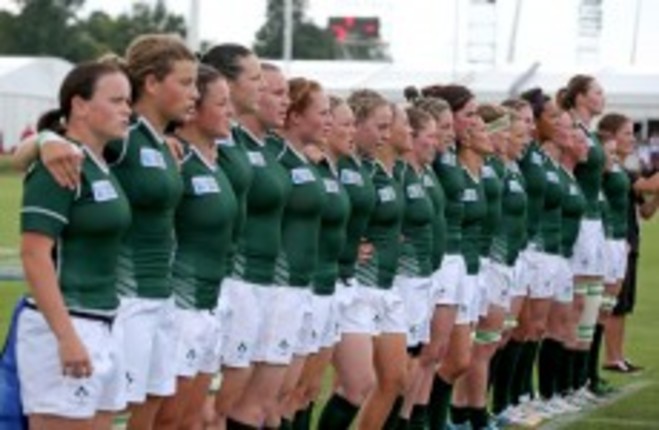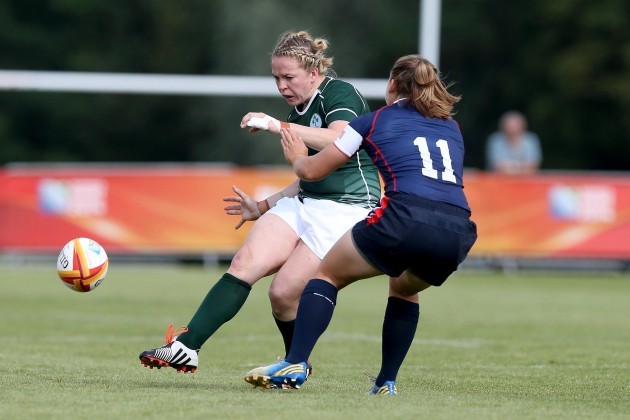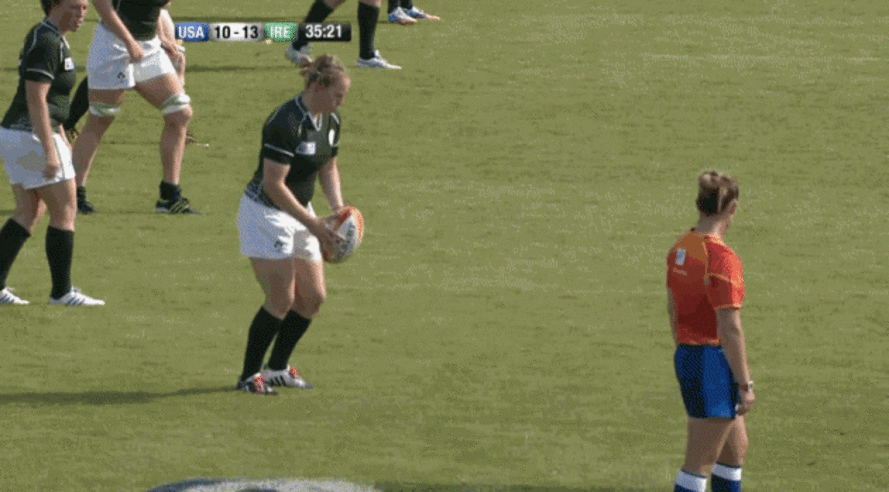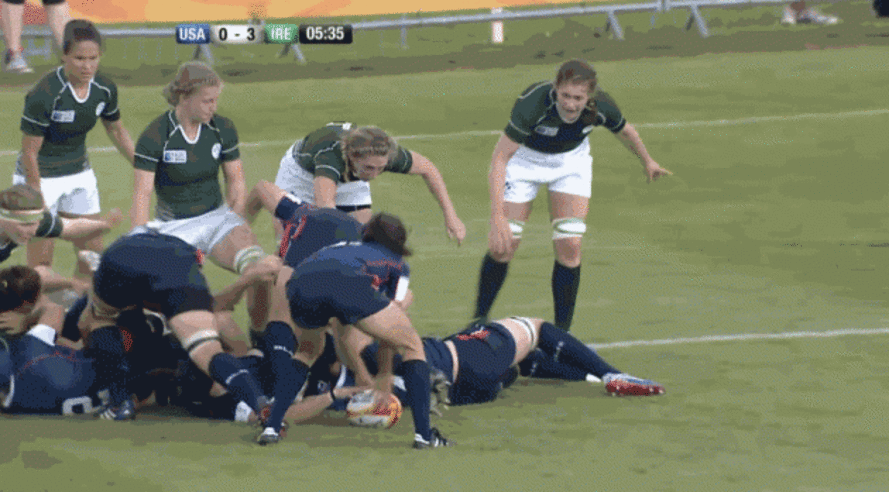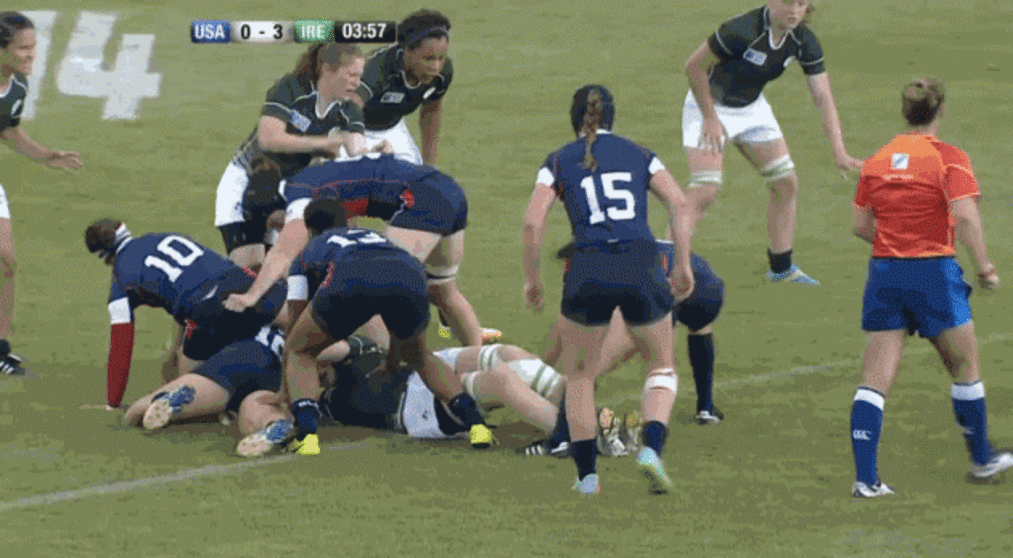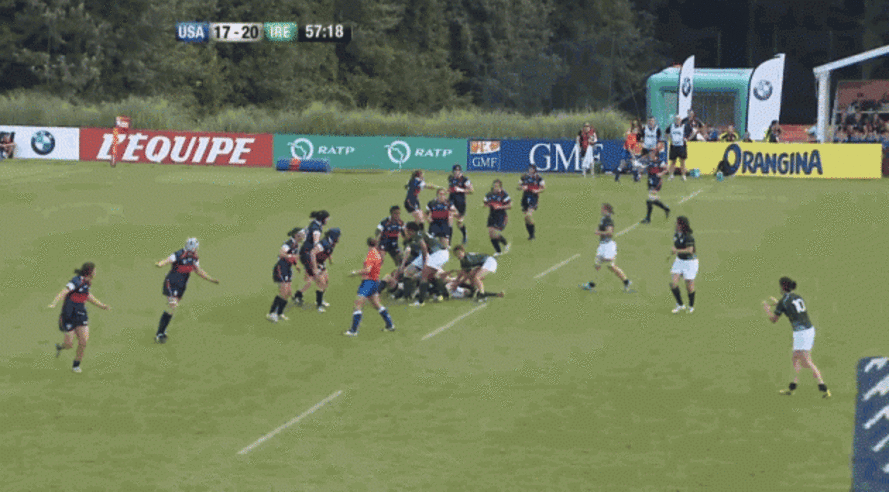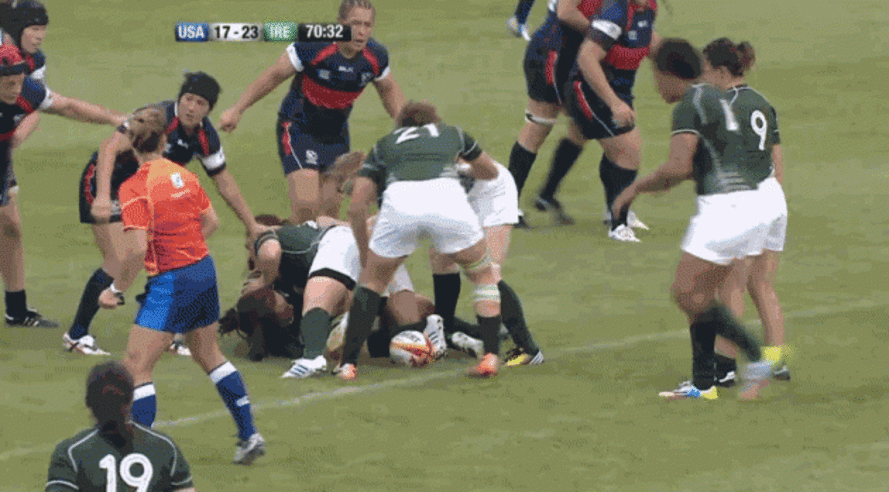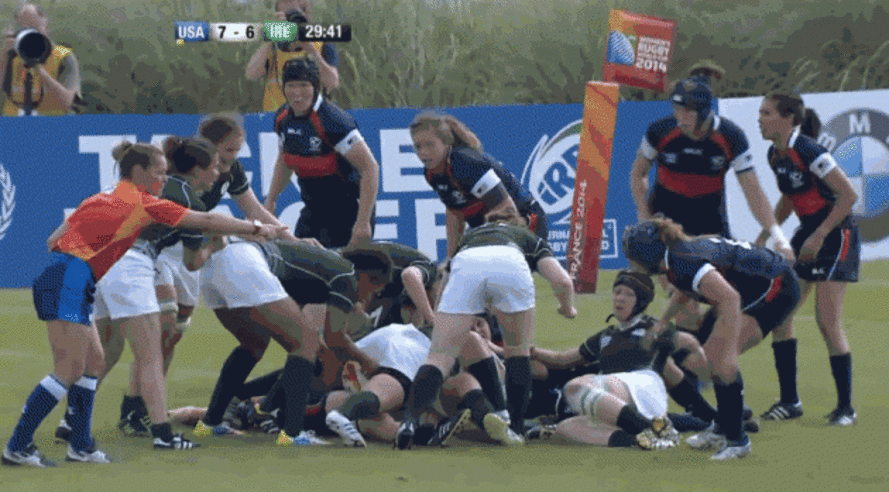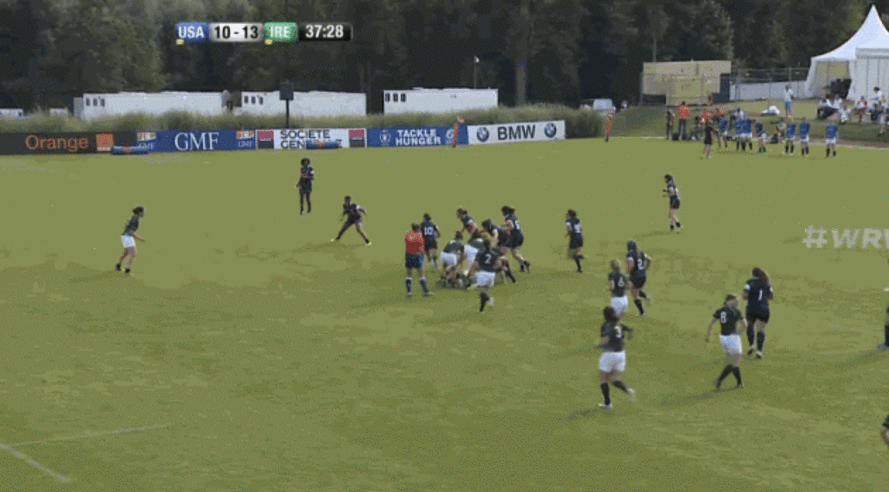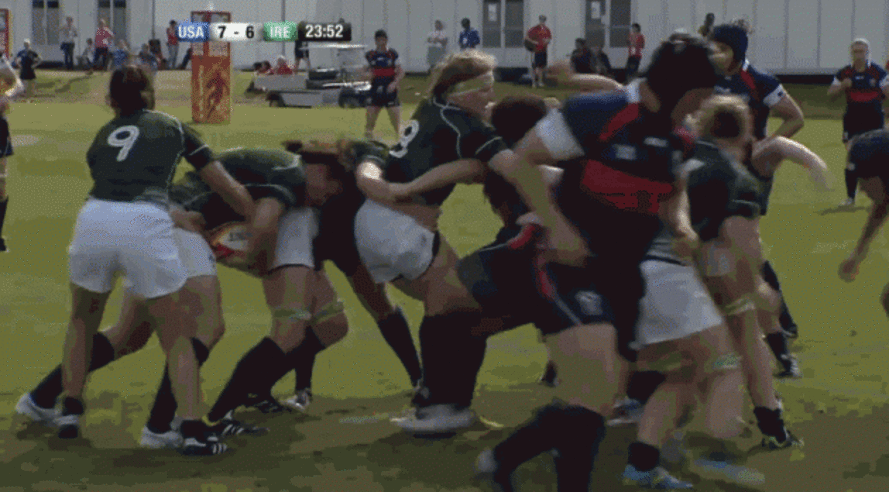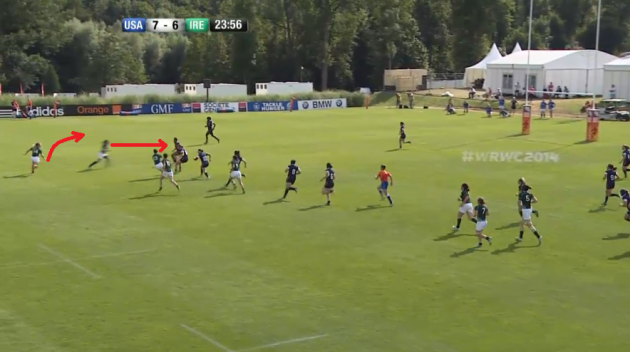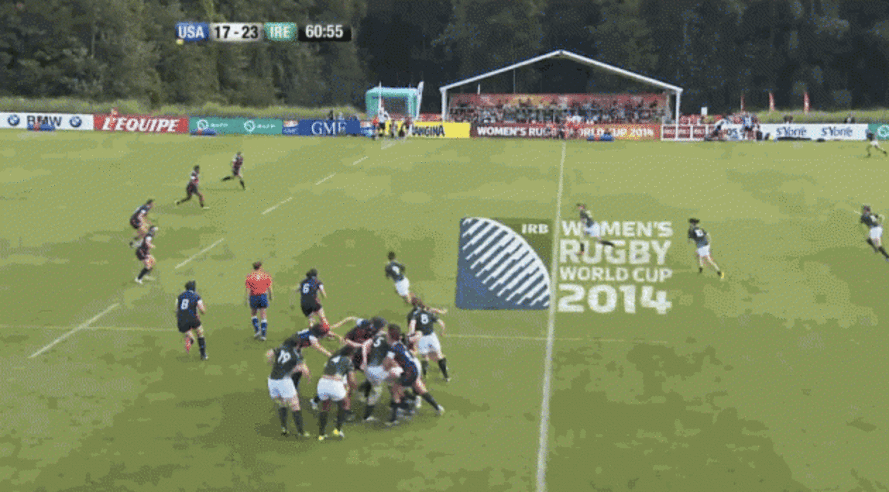IRELAND WOMEN GOT their Rugby World Cup campaign off to a strong start on Friday with a 23-17 victory over the USA in Marcoussis, France.
The Irish win demonstrated this experienced squad’s tactical intelligence, technical quality and impressive conditioning, while also leaving plenty of room for improvement ahead of Tuesday’s meeting with reigning champions New Zealand.
Fiona Coghlan-captained Ireland will need to produce one of their finest performances ever if they are to beat the Black Ferns on the occasion of the first meeting between the teams in the 15-a-side code.
Tactical smarts
One of the major positives as Ireland prepare for New Zealand is the fact that their game plans in recent seasons have been so cleverly put together. Even on the occasions Philip Doyle’s side have lost in the last two years, it has been hard to fault their intentions.
Defeats to England and France in this year’s Six Nations were down to individual and unit errors, rather than a poorly-constructed game plan. Against the US, we saw Ireland carry out another craftily-mapped victory, and one which also showed a crucial element of tactical adaptability.
As pointed out by Scrum Queens ahead of the fixture, Ireland are the oldest team at the World Cup, while the Americans are the heaviest.
While some might view that as a disadvantage to the Irish in athletic terms, the positives are overwhelming. Players like Lynne Cantwell, Coghlan, Tania Rosser, Niamh Briggs and Nora Stapleton are experienced players, capable of making smart in-game decisions.
The fact that the US are the bulkiest and tallest team involved in the World Cup fed right into the hands of the Irish, who put together the ideal game plan for countering those physical strengths.
Territory
While the Americans are powerful in contact and always willing to put their bodies on the line, they do lack a degree of discipline. Ireland recognised that in their pre-tournament analysis and went about exploiting it as often as possible.
By kicking deep behind the US at every opportunity, Ireland ensured that the game would be played in the Americans’ defensive half and that any infringements would ensure Briggs had a kickable shot at goal.
The first illustration of Ireland’s plan came from the opening kick-off of the game, as Briggs launched her effort deep into the US 22. This tactic was repeated every single time Ireland had a restart; they had no intention of dropping kicks short and competing in the air.
Ireland’s kicking for territory was not only centred around the restarts, as they put boot to ball on a high number of turnovers in open play too.
Joe Schmidt spent a training session with the squad in the build-up to the World Cup working on breakdown decision-making and it appeared that the Irish ladies learned extremely quickly from the Kiwi. That said, there was an existing breakdown quality among the Irish ladies even before Schmidt lent a helping hand.
There were a number of technically superb steals on the deck from Ireland on Friday, and they were followed up with long kicks into US territory more often than not.
We get one such example in the video above, as the highly-rated American wing Vanesha McGee [who Ireland marshalled well throughout] counters from an original Irish kick. Alison Miller makes an excellent tackle in tracking McGee and Ireland flood the breakdown.
It’s worth noting first how hard Siobhan Fleming, Sophie Spence and then Heather O’Brien work to get into position for the steal, easily beating the American support to the tackled player.
The turnover is completed, allowing Rosser to hit Briggs with a pass. The Munster fullbacks’ kick deep into space is powerful, forcing the US to turn and eventually resulting in an Ireland line-out well inside the American half.
In the second example above, it’s openside flanker Claire Molloy and replacement Paula Fitzpatrick who steal possession for Ireland, jackaling over the ball and allowing Gillian Bourke and Ailis Egan to drive in behind.
Upon retrieving the ball, Ireland’s reaction is identical to the first example. Rosser finds Jenny Murphy with an accurate pass from the base of the ruck and the inside centre [who was excellent off the bench] locates space deep behind the US defence with her kick.
Once Ireland got into these positions inside the States’ defensive 30 metres, they were able to force penalties through their phase play. Having a place kicker of Briggs’ quality feeds into that tactic and she was able to reward her teams’ efforts with accuracy from the tee, as below.
US power
This territorial-focused game plan of Ireland’s, which was particularly effective in the second half, was also based on negating the sheer finishing power of the US from close range.
The likes of Jamie Burke, Kate Daley, Carmen Farmer and Lynelle Kugler are explosive in their strength, meaning that defending against them close to one’s own tryline can be extremely demanding.
That was exemplified in Kugler’s early try against Ireland [above], as she turned on the footwork to burst past a couple of despairing tackles.
Similarly, the try Farmer scored immediately after the half-time break showed that the Americans are a force to be reckoned with when they get a foothold in the opposition 22. Ireland head coach Doyle put the five-pointer [which Kimbar Rozier converted] down to a loss of concentration from Ireland, which is entirely valid but also ignores the US power.
We are looking at this game from an Irish point of view, however, and the poor tackling in this passage will have rankled with Coghlan and her teammates. For long spells of the game, the Irish defence was strong, with a focus on chop tackles around the knees of the American ball carriers.
We see an illustration of that low tackle focus in the GIF below, as first Bourke and then centre Grace Davitt go in low and complete their tackles with almost immediate effect.
The above is likely to remain the blueprint for Ireland as they prepare for a Kiwi side that has added brawn to their undeniable skill set in recent years. When the Irish allowed their tackling to slip up into attempted body shots, the US thrived.
New Zealand would be even more unforgiving of a lack of accuracy in the tackle area.
Mauling success
Another key element of the Irish game plan against the US was the maul. Doyle’s side have used the driven line-out to great effect in the last two years and it appears to be continuing to improve under the watch of this Irish management.
The Irish management are fortunate to have a number of technically strong maulers in their squad, meaning that any relative lack of size against a heavy team like the US is more than compensated for.
There were numerous good examples of Ireland’s attacking mauling against the US, but the clip above perhaps demonstrates their success best. The line-out [which stuttered early on in Friday's game, but improved thereafter] functions smoothly, setting a fine platform.
There is no attempt at the sack by the US here, meaning Ireland can get themselves prepared to drive as swiftly as possible. The ball is cleverly worked back to Bourke arriving at the tail as the initial shunt begins.
Ireland are impressive in their ability to continually find weak points as their maul drives forward, the players maintaining their low body positions and dealing comfortably as the US defence drags some of the leading players away or down to the ground.
New Zealand will have picked out the maul as an Irish strength to target, but the Irish ladies will be keen to continue to use it as an attacking weapon.
Narrow attack
The power of the US players means that head coach Pete Steinberg likes his side to play with an aggressive defensive line. There is no hesitation on the Americans’ part in rushing up in defence, either as a collective unit or as individuals shooting out of the line.
The GIF above paints a picture of that US trait, as Shaina Turley hammers two Irishwomen in the tackle. The aggression of the American defensive line manageed to stunt some of Ireland’s back play, which we will return to later.
In order to counter the American line speed, Ireland had to adapt their game plan, shifting to a more narrow attacking focus in phase play and targeting Steinberg’s team around the fringes of rucks.
There were countless examples of the Irish ‘pick and go’ as they made short carries close in to the preceding rucks, either by picking and running directly from the base or through short one-out passes from Rosser.
When Ireland did pick and go, they did so effectively. In the example above, we see some high-quality ‘leeching’ or ‘latching’ from the supporting players, engaging onto the ball carrier and powering them through contact.
First Murphy carries with Spence leeching on expertly, then O’Brien takes the ball on with Bourke providing the support. This leech technique also results in ‘safe’ rucks for Ireland, which proved invaluable as they ran the clock down late in the second half.
Ireland scored both of their tries directly from picks and gos against the States, underlining how valuable a tactic it was on Friday. We see the first of those above, which tighthead prop Egan touched down.
Again, the leeching from Ireland is evident and important, as Spence is driven forward by Coghlan and then Bourke helps Egan over the tryline. Clearly the ball carrier is the key here, but that extra shove of momentum can so often make the difference.
The fact that these pick and gos may not have been a defined part of Ireland’s game plan makes them more impressive; Coghlan and her team had the ability to identify a weakness in the defence, tactically adapt and then exploit it ruthlessly.
Fullback Briggs managed to get over for a remarkably similar try, aided by outside centre Cantwell, demonstrating that anything the forwards can do, the backs can emulate.
Backline frustration
While the Americans’ aggressive defence did cut out options for Ireland to go wide on several occasions, out-half Nora Stapleton and her backline may have been frustrated by an inability to cut loose.
There were clear signs of the Ireland backs’ quality, more obviously in the first half. Attack/skills/backs coach Greg McWilliams has been working diligently with the squad to improve skill levels this season, and that was on show in the passage below.
Stapleton and Cantwell use simple, effective passing to get the ball into the hands of Miller wide on the left, where the winger makes good yardage. In Miller and Ashleigh Baxter, Ireland have two superb running talents and they will look to get the ball to their wide options more often in coming games.
There were also some clever lines run in the Irish backline on occasion against the US, forcing defenders into making instant and demanding decisions when faced with multiple attacking options.
We get an example of that above, as Ireland bring Cantwell’s passing skills in at second receiver and Davitt runs a straightening line from the 13 channel.
Out the back door is Baxter, coming off her wing to run an arcing line from right to left. The speed at which Davitt runs her decoy line forces the US centre partnership to sit back on their heels for a split second, opening space outside Akalaini Baravilala for Baxter to exploit.
Ireland clearly have the shapes, structures and starter plays in place; they will simply look to be far more effective and clinical in carrying them out against New Zealand on Tuesday.
There were a few instances in which Ireland nearly broke free in the backs against the US, but just couldn’t find the crucial pass. We see that in the GIF below, as Stapleton’s pass eludes Cantwell, who is arriving on a clever line.
The intention is obvious and it’s almost perfect, exploiting the shooting Emilie Bydwell, but the pass goes to deck and the opportunity is lost. Cantwell and her backs will demand more of themselves against the Kiwis.
Greatest challenge
There were many positives to take from the victory over a strong US side, but no one will need to tell Ireland that beating New Zealand will require another step up in physical intensity, tactical intelligence and technical accuracy.
The 2013 Grand Slam was a clear peak for this group of players, but Tuesday’s clash with the world champions is their biggest challenge yet. Coghlan and her teammates have utter belief in their ability to compete with the very best, and it is a thrilling prospect to see them go up against exactly that.
There is encouragement to be taken in the likelihood that Ireland will have identified any New Zealand weaknesses and formulated a game plan to exploit them.
